框架源码系列十:Spring AOP(AOP的核心概念回顾、Spring中AOP的用法、Spring AOP 源码学习)
一、AOP的核心概念回顾
https://docs.spring.io/spring/docs/5.1.3.RELEASE/spring-framework-reference/core.html#aop
我们先来看一下下面的这张图
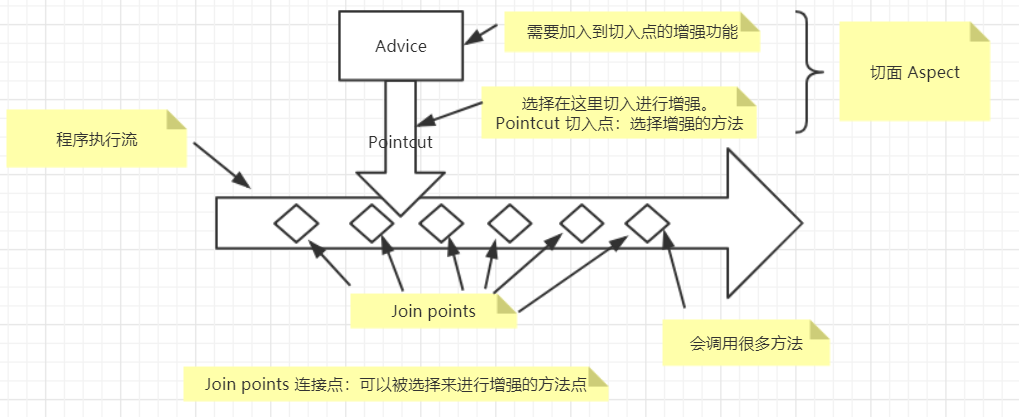
说明:
程序运行时会调用很多方法,调用的很多方法就叫做Join points(连接点,可以被选择来进行增强的方法点),在方法的前或者后选择一个地方来切入,切入的的地方就叫做Pointcut(切入点,选择增强的方法),然后把要增强的功能(Advice)加入到切入点所在的位置。Advice和Pointcut组成一个切面(Aspect)
AOP的几个概念:

Advice、Pointcut、Weaving的特点:
Advice(功能增强):
1)用户性:由用户提供增强功能的逻辑代码
2)变化的:不同的增强需求,会有不同的逻辑
3)可选时机:可选择在方法前、后、异常时进行功能增强
4)多重的:同一个切入点上可以有多重增强
Pointcut(切入点):
1)用户性:由用户来指定
2)变化的:用户可灵活指定
3)多点性:用户可以选择在多个点上进行功能增强
Weaving(织入):
1)无侵入性,因为不改变原类的代码
2)我们在框架中实现
二、Spring中AOP的用法
1. 传统Advisor方式
掌握用法:
1)编程提供Advice,实现对应的Advice接口
2)配置Advisor(advice+pointcut)
Advice接口:
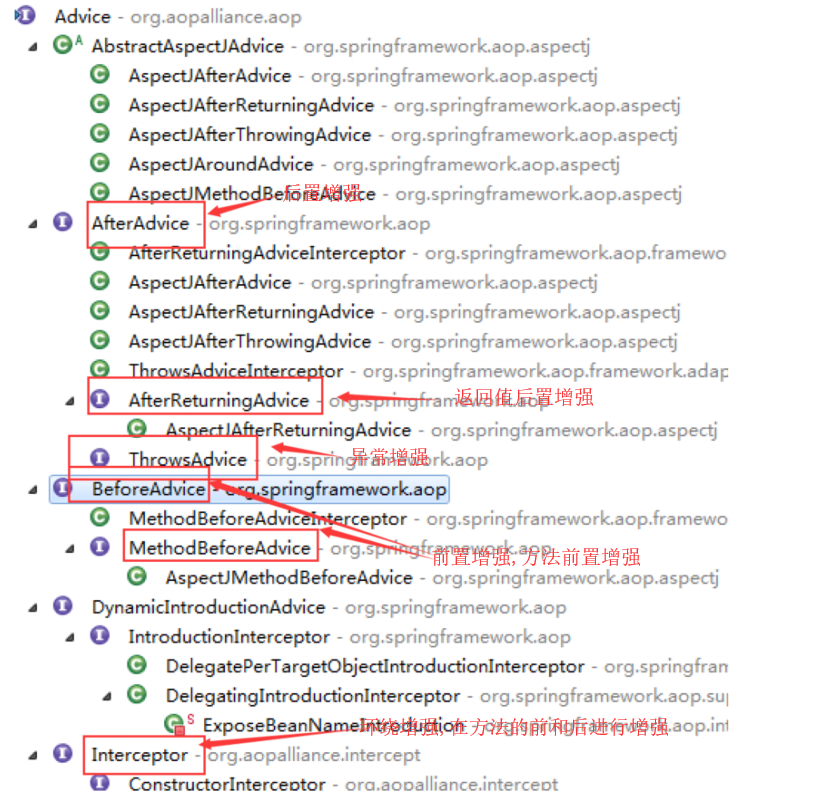
示例代码:
被增强的目标对象:
BeanQ
- package com.study.leesmall.spring.sample.aop;
- //被增强的目标对象
- public class BeanQ {
- public void do1(String task, int time) {
- System.out.println("-------------do1 do " + task + " time:" + time);
- }
- public String service1(String name) {
- System.out.println("-------------servce1 do " + name);
- return name;
- }
- public String service2(String name) {
- System.out.println("-------------servce2 do " + name);
- if (!"s1".equals(name)) {
- throw new IllegalArgumentException("参数 name != s1, name=" + name);
- }
- return name + " hello!";
- }
- }
编程提供Advice,实现对应的Advice接口:
前置增强:
MyBeforeAdvice
- package com.study.leesmall.spring.sample.aop;
- import java.lang.reflect.Method;
- import org.springframework.aop.MethodBeforeAdvice;
- //前置增强
- public class MyBeforeAdvice implements MethodBeforeAdvice {
- @Override
- public void before(Method method, Object[] args, Object target) throws Throwable {
- System.out.println("------ MyBeforeAdvice before 增强 " + target + " " + method);
- }
- }
环绕增强:
MyArroundAdvice
- package com.study.leesmall.spring.sample.aop;
- import org.aopalliance.intercept.MethodInterceptor;
- import org.aopalliance.intercept.MethodInvocation;
- //环绕增强
- public class MyArroundAdvice implements MethodInterceptor {
- @Override
- public Object invoke(MethodInvocation invocation) throws Throwable {
- System.out.println("--------- 环绕 -前增强");
- Object ret = invocation.proceed();
- System.out.println("--------- 环绕 -后增强");
- return ret;
- }
- }
在/spring-source-study/src/main/java/com/study/leesmall/spring/sample/aop/application.xml里面配置Advisor(advice+pointcut):
- <?xml version="1.0" encoding="UTF-8"?>
- <beans xmlns="http://www.springframework.org/schema/beans"
- xmlns:xsi="http://www.w3.org/2001/XMLSchema-instance"
- xmlns:context="http://www.springframework.org/schema/context"
- xmlns:aop="http://www.springframework.org/schema/aop"
- xsi:schemaLocation="http://www.springframework.org/schema/beans
- http://www.springframework.org/schema/beans/spring-beans.xsd
- http://www.springframework.org/schema/context
- http://www.springframework.org/schema/context/spring-context.xsd
- http://www.springframework.org/schema/aop
- http://www.springframework.org/schema/aop/spring-aop.xsd">
- <!-- 传统方式的aop begin -->
- <!--被增强的目标对象 -->
- <bean id="BeanQ" class="com.study.leesmall.spring.sample.aop.BeanQ" />
- <!--配置advice -->
- <bean id="myBeforeAdvice" class="com.study.leesmall.spring.sample.aop.MyBeforeAdvice" />
- <bean id="yyArroundAdvice" class="com.study.leesmall.spring.sample.aop.MyArroundAdvice" />
- <!--配置pointcut -->
- <aop:config >
- <!--全局切入点,任何一个aop-config都可以使用 -->
- <aop:pointcut id="doMethods" expression="execution(* com.study.leesmall.spring.sample.aop.*.do*(..))" />
- <aop:advisor advice-ref="myBeforeAdvice" pointcut-ref="doMethods" />
- <aop:advisor advice-ref="yyArroundAdvice"
- pointcut="execution(* com.study.leesmall.spring.sample.aop.*.service*(..))"/>
- </aop:config>
- <!-- 传统方式的aop end -->
- </beans>
配置文件里面的注意点:
<aop:config> 的属性了解
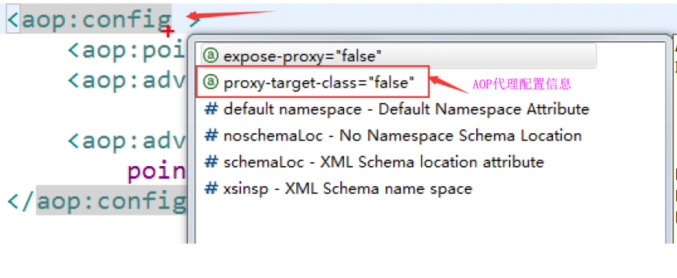
- proxy-target-class="false"使用jdk的动态代理 默认配置
- proxy-target-class="true"使用cglib的动态代理
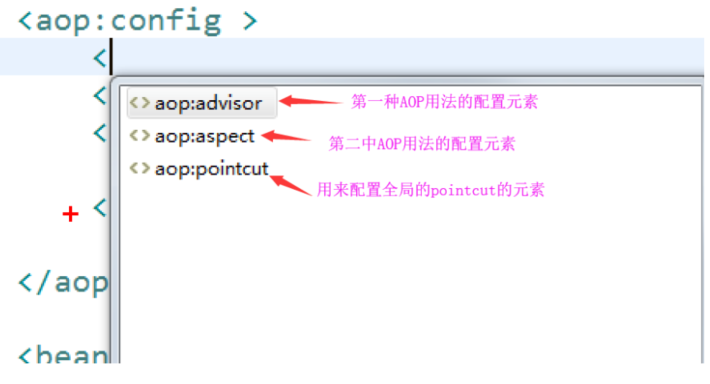
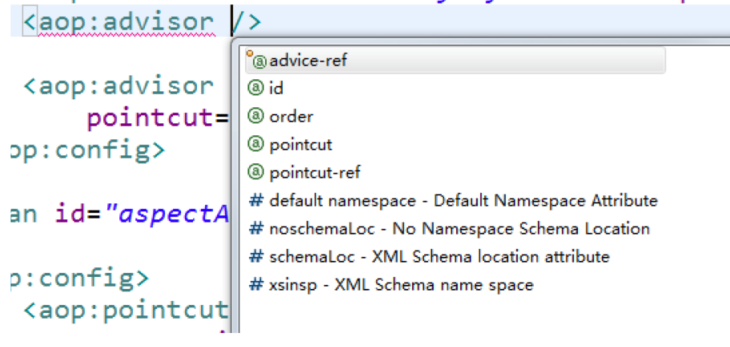
掌握 spring Aop 的 API:
Advice:

Advisor的代码:
- * Copyright 2002-2017 the original author or authors.
- package org.springframework.aop;
- import org.aopalliance.aop.Advice;
- /**
- * Base interface holding AOP <b>advice</b> (action to take at a joinpoint)
- * and a filter determining the applicability of the advice (such as
- * a pointcut). <i>This interface is not for use by Spring users, but to
- * allow for commonality in support for different types of advice.</i>
- *
- * <p>Spring AOP is based around <b>around advice</b> delivered via method
- * <b>interception</b>, compliant with the AOP Alliance interception API.
- * The Advisor interface allows support for different types of advice,
- * such as <b>before</b> and <b>after</b> advice, which need not be
- * implemented using interception.
- *
- * @author Rod Johnson
- * @author Juergen Hoeller
- */
- public interface Advisor {
- /**
- * Common placeholder for an empty {@code Advice} to be returned from
- * {@link #getAdvice()} if no proper advice has been configured (yet).
- * @since 5.0
- */
- Advice EMPTY_ADVICE = new Advice() {};
- /**
- * Return the advice part of this aspect. An advice may be an
- * interceptor, a before advice, a throws advice, etc.
- * @return the advice that should apply if the pointcut matches
- * @see org.aopalliance.intercept.MethodInterceptor
- * @see BeforeAdvice
- * @see ThrowsAdvice
- * @see AfterReturningAdvice
- */
- Advice getAdvice();
- /**
- * Return whether this advice is associated with a particular instance
- * (for example, creating a mixin) or shared with all instances of
- * the advised class obtained from the same Spring bean factory.
- * <p><b>Note that this method is not currently used by the framework.</b>
- * Typical Advisor implementations always return {@code true}.
- * Use singleton/prototype bean definitions or appropriate programmatic
- * proxy creation to ensure that Advisors have the correct lifecycle model.
- * @return whether this advice is associated with a particular target instance
- */
- boolean isPerInstance();
- }
Pointcut:

Pointcut的子类:
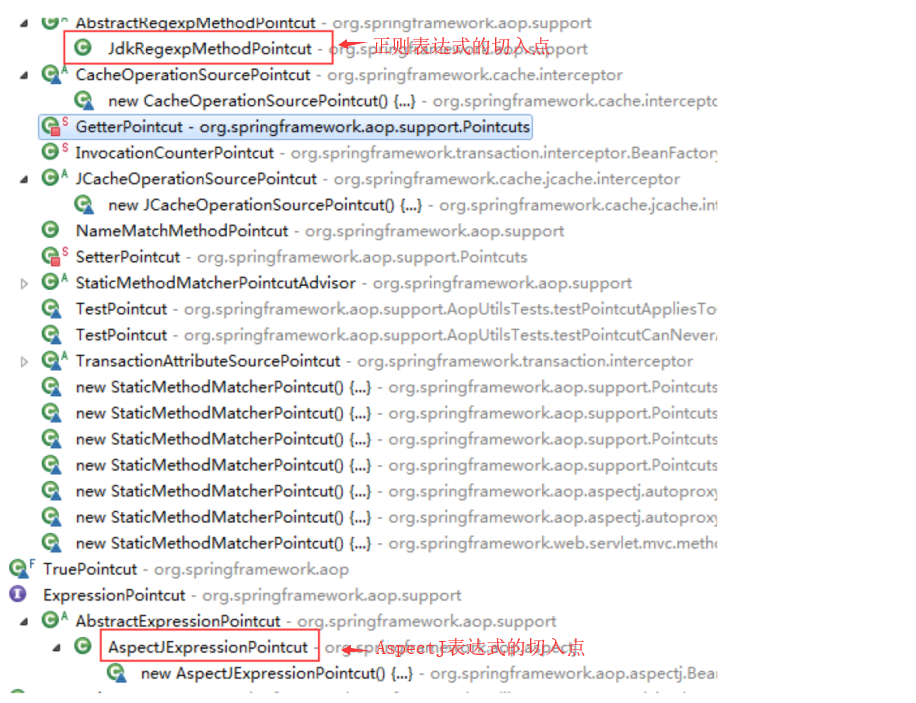
Advisor的子类:

PointcutAdvisor扩展了Advisor以后就会有一个切面Aspect=Advice+Pointcut
PointcutAdvisor的代码:
- * Copyright 2002-2012 the original author or authors.
- package org.springframework.aop;
- /**
- * Superinterface for all Advisors that are driven by a pointcut.
- * This covers nearly all advisors except introduction advisors,
- * for which method-level matching doesn't apply.
- *
- * @author Rod Johnson
- */
- public interface PointcutAdvisor extends Advisor {
- /**
- * Get the Pointcut that drives this advisor.
- */
- Pointcut getPointcut();
- }
PointcutAdvisor的子类:

测试类:
AopMain
- package com.study.leesmall.spring.sample.aop;
- import org.springframework.context.ApplicationContext;
- import org.springframework.context.support.GenericXmlApplicationContext;
- public class AopMain {
- public static void main(String[] args) {
- ApplicationContext context = new GenericXmlApplicationContext(
- "classpath:com/study/leesmall/spring/sample/aop/application.xml");
- BeanQ bq = context.getBean(BeanQ.class);
- bq.do1("task1", 20);
- System.out.println();
- bq.service1("service1");
- System.out.println();
- bq.service2("ssss");
- }
- }
测试结果:
- ------ MyBeforeAdvice before 增强 com.study.leesmall.spring.sample.aop.BeanQ@1d119efb public void com.study.leesmall.spring.sample.aop.BeanQ.do1(java.lang.String,int)
- -------------do1 do task1 time:20
- --------- 环绕 -前增强
- -------------servce1 do service1
- --------- 环绕 -后增强
- --------- 环绕 -前增强
- -------------servce2 do ssss
- Exception in thread "main" java.lang.IllegalArgumentException: 参数 name != s1, name=ssss
- at com.study.leesmall.spring.sample.aop.BeanQ.service2(BeanQ.java:18)
- at com.study.leesmall.spring.sample.aop.BeanQ$$FastClassBySpringCGLIB$$3d1515ac.invoke(<generated>)
- at org.springframework.cglib.proxy.MethodProxy.invoke(MethodProxy.java:218)
- at org.springframework.aop.framework.CglibAopProxy$CglibMethodInvocation.invokeJoinpoint(CglibAopProxy.java:749)
- at org.springframework.aop.framework.ReflectiveMethodInvocation.proceed(ReflectiveMethodInvocation.java:163)
- at com.study.leesmall.spring.sample.aop.MyArroundAdvice.invoke(MyArroundAdvice.java:12)
- at org.springframework.aop.framework.ReflectiveMethodInvocation.proceed(ReflectiveMethodInvocation.java:186)
- at org.springframework.aop.interceptor.ExposeInvocationInterceptor.invoke(ExposeInvocationInterceptor.java:93)
- at org.springframework.aop.framework.ReflectiveMethodInvocation.proceed(ReflectiveMethodInvocation.java:186)
- at org.springframework.aop.framework.CglibAopProxy$DynamicAdvisedInterceptor.intercept(CglibAopProxy.java:688)
- at com.study.leesmall.spring.sample.aop.BeanQ$$EnhancerBySpringCGLIB$$2fc5343.service2(<generated>)
- at com.study.leesmall.spring.sample.aop.AopMain.main(AopMain.java:18)
2. Aspect语法方式
Aspect的advice是基于方法的。
掌握用法:
1)定义包含Advice方法的Bean类
2)配置Bean定义
3)配置Aspect(引用包含advice方法的bean),在里面配置各种Advice(method+pointcut)
定义包含Advice方法的Bean类:
AspectAdviceBean:
- package com.study.leesmall.spring.sample.aop;
- import org.aspectj.lang.JoinPoint;
- import org.aspectj.lang.ProceedingJoinPoint;
- //定义包含 Advice 方法的 Bean 类
- public class AspectAdviceBean {
- public void before1() {
- System.out.println("----------- AspectAdviceBean before1 增强 ");
- }
- //JoinPoint看具体哪个方法被增强了,JoinPoint一定要放在第一个参数
- public void before2(JoinPoint jp) {
- System.out.println("----------- AspectAdviceBean before2 增强 for " + jp);
- }
- //调用被增强的方法时传参数
- //<aop:before method="before3" pointcut="execution(* com.study.leesmall.spring.sample.aop.*.do*(..))
- //and args(tk,..)" arg-names=""/>
- //args(tk,..)有两个意思,第一个意思是被增强的方法的第一个参数的类型要和before3的参数tk的类型一样
- //第二个意思是被增强的方法的第一个参数tk要赋值给before3的参数tk
- //arg-names="" 当不能确定方法参数的顺序时可以用这个参数指定arg-names="param1,param2"
- public void before3(String tk) {
- System.out.println("----------- AspectAdviceBean before3 增强 参数tk= " + tk);
- }
- //调用被增强的方法时传参数
- public void before4(String tk, int ti) {
- System.out.println("----------- AspectAdviceBean before4 增强 参数tk= " + tk + " ti=" + ti);
- }
- //ProceedingJoinPoint正在处理的方法
- public Object arround1(ProceedingJoinPoint pjp) throws Throwable {
- System.out.println("----------- AspectAdviceBean arround1 环绕-前增强 for " + pjp);
- Object ret = pjp.proceed();
- System.out.println("----------- AspectAdviceBean arround1 环绕-后增强 for " + pjp);
- return ret;
- }
- public Object arround2(ProceedingJoinPoint pjp, String name) throws Throwable {
- System.out.println("--------- AspectAdviceBean arround2 参数 name=" + name);
- System.out.println("----------- AspectAdviceBean arround2 环绕-前增强 for " + pjp);
- Object ret = pjp.proceed();
- System.out.println("----------- AspectAdviceBean arround2 环绕-后增强 for " + pjp);
- return ret;
- }
- public void afterReturning(Object retValue) {
- System.out.println("----------- AspectAdviceBean afterReturning 增强 , 返回值为: " + retValue);
- }
- public void afterThrowing(JoinPoint jp, Exception e) {
- System.out.println("----------- AspectAdviceBean afterThrowing 增强 for " + jp);
- System.out.println("----------- AspectAdviceBean afterThrowing 增强 异常 :" + e);
- }
- public void after(JoinPoint jp) {
- System.out.println("----------- AspectAdviceBean after 增强 for " + jp);
- }
- }
JoinPoint和ProceedingJoinPoint :

在/spring-source-study/src/main/java/com/study/leesmall/spring/sample/aop/application.xml里面配置Bean定义
- <?xml version="1.0" encoding="UTF-8"?>
- <beans xmlns="http://www.springframework.org/schema/beans"
- xmlns:xsi="http://www.w3.org/2001/XMLSchema-instance"
- xmlns:context="http://www.springframework.org/schema/context"
- xmlns:aop="http://www.springframework.org/schema/aop"
- xsi:schemaLocation="http://www.springframework.org/schema/beans
- http://www.springframework.org/schema/beans/spring-beans.xsd
- http://www.springframework.org/schema/context
- http://www.springframework.org/schema/context/spring-context.xsd
- http://www.springframework.org/schema/aop
- http://www.springframework.org/schema/aop/spring-aop.xsd">
- <!-- 传统方式的aop begin -->
- <!--被增强的目标对象 -->
- <bean id="BeanQ" class="com.study.leesmall.spring.sample.aop.BeanQ" />
- <!--配置advice -->
- <bean id="myBeforeAdvice" class="com.study.leesmall.spring.sample.aop.MyBeforeAdvice" />
- <bean id="yyArroundAdvice" class="com.study.leesmall.spring.sample.aop.MyArroundAdvice" />
- <!--配置pointcut -->
- <aop:config >
- <aop:pointcut id="doMethods" expression="execution(* com.study.leesmall.spring.sample.aop.*.do*(..))" />
- <aop:advisor advice-ref="myBeforeAdvice" pointcut-ref="doMethods" />
- <aop:advisor advice-ref="yyArroundAdvice"
- pointcut="execution(* com.study.leesmall.spring.sample.aop.*.service*(..))"/>
- </aop:config>
- <!-- 传统方式的aop end -->
- <!-- AspectJ的aop begin -->
- <!-- 配置了包含advice方法的Bean -->
- <bean id="aspectAdviceBean" class="com.study.leesmall.spring.sample.aop.AspectAdviceBean" />
- </beans>
3)配置Aspect(引用包含advice方法的bean),在里面配置各种Advice(method+pointcut)
- <?xml version="1.0" encoding="UTF-8"?>
- <beans xmlns="http://www.springframework.org/schema/beans"
- xmlns:xsi="http://www.w3.org/2001/XMLSchema-instance"
- xmlns:context="http://www.springframework.org/schema/context"
- xmlns:aop="http://www.springframework.org/schema/aop"
- xsi:schemaLocation="http://www.springframework.org/schema/beans
- http://www.springframework.org/schema/beans/spring-beans.xsd
- http://www.springframework.org/schema/context
- http://www.springframework.org/schema/context/spring-context.xsd
- http://www.springframework.org/schema/aop
- http://www.springframework.org/schema/aop/spring-aop.xsd">
- <!-- 传统方式的aop begin -->
- <!--被增强的目标对象 -->
- <bean id="BeanQ" class="com.study.leesmall.spring.sample.aop.BeanQ" />
- <!--配置advice -->
- <bean id="myBeforeAdvice" class="com.study.leesmall.spring.sample.aop.MyBeforeAdvice" />
- <bean id="yyArroundAdvice" class="com.study.leesmall.spring.sample.aop.MyArroundAdvice" />
- <!--配置pointcut -->
- <aop:config >
- <aop:pointcut id="doMethods" expression="execution(* com.study.leesmall.spring.sample.aop.*.do*(..))" />
- <aop:advisor advice-ref="myBeforeAdvice" pointcut-ref="doMethods" />
- <aop:advisor advice-ref="yyArroundAdvice"
- pointcut="execution(* com.study.leesmall.spring.sample.aop.*.service*(..))"/>
- </aop:config>
- <!-- 传统方式的aop end -->
- <!-- AspectJ的aop begin -->
- <!-- 配置了包含advice方法的Bean -->
- <bean id="aspectAdviceBean" class="com.study.leesmall.spring.sample.aop.AspectAdviceBean" />
- <!--配置 Aspect (引用包含 advice 方法的 bean),在里面配置各种 Advice(method + pointcut) -->
- <aop:config>
- <aop:pointcut id="services" expression="execution(* com.study.leesmall.spring.sample.aop.*.service*(..))" />
- <aop:aspect id="a1" ref="aspectAdviceBean" order="1">
- <aop:before method="before1" pointcut-ref="doMethods" />
- <aop:before method="before2" pointcut-ref="doMethods"/>
- <!--args(tk,..)有两个意思,第一个意思是被增强的方法的第一个参数的类型要和before3的参数tk的类型一样
- 第二个意思是被增强的方法的第一个参数tk要赋值给before3的参数tk;
- arg-names="" 当不能确定方法参数的顺序时可以用这个参数指定arg-names="param1,param2"
- -->
- <aop:before method="before3" pointcut="execution(* com.study.leesmall.spring.sample.aop.*.do*(..)) and args(tk,..)"/>
- <aop:before method="before4" pointcut="execution(* com.study.leesmall.spring.sample.aop.*.do*(..)) and args(tk,ti)"/>
- <aop:around method="arround1" pointcut-ref="services"/>
- <aop:around method="arround2" pointcut="execution(* com.study.leesmall.spring.sample.aop.*.service*(..)) and args(name)"/>
- <aop:after-returning method="afterReturning" pointcut-ref="services" returning="retValue"/>
- <aop:after-throwing method="afterThrowing" pointcut-ref="services" throwing="e"/>
- <aop:after method="after" pointcut-ref="services"/>
- </aop:aspect>
- </aop:config>
- <!-- AspectJ的aop end -->
- </beans>
被增强的目标对象:
- package com.study.leesmall.spring.sample.aop;
- //被增强的目标对象
- public class BeanQ {
- public void do1(String task, int time) {
- System.out.println("-------------do1 do " + task + " time:" + time);
- }
- public String service1(String name) {
- System.out.println("-------------servce1 do " + name);
- return name;
- }
- public String service2(String name) {
- System.out.println("-------------servce2 do " + name);
- /**if (!"s1".equals(name)) {
- throw new IllegalArgumentException("参数 name != s1, name=" + name);
- }**/
- return name + " hello!";
- }
- }
测试类:
AopMain
- package com.study.leesmall.spring.sample.aop;
- import org.springframework.context.ApplicationContext;
- import org.springframework.context.support.GenericXmlApplicationContext;
- public class AopMain {
- public static void main(String[] args) {
- ApplicationContext context = new GenericXmlApplicationContext(
- "classpath:com/study/leesmall/spring/sample/aop/application.xml");
- BeanQ bq = context.getBean(BeanQ.class);
- bq.do1("task1", 20);
- System.out.println();
- bq.service1("service1");
- System.out.println();
- bq.service2("ssss");
- }
- }
测试结果:
- ----------- AspectAdviceBean before1 增强
- ----------- AspectAdviceBean before2 增强 for execution(void com.study.mike.spring.sample.aop.BeanQ.do1(leesmall,int))
- ----------- AspectAdviceBean before3 增强 参数tk= task1
- ----------- AspectAdviceBean before4 增强 参数tk= task1 ti=20
- ------ MyBeforeAdvice before 增强 com.study.mike.spring.sample.aop.BeanQ@3a0baae5 public void com.study.mike.spring.sample.aop.BeanQ.do1(java.lang.leesmall,int)
- -------------do1 do task1 time:20
- ----------- AspectAdviceBean arround1 环绕-前增强 for execution(leesmall com.study.mike.spring.sample.aop.BeanQ.service1(leesmall))
- --------- AspectAdviceBean arround2 参数 name=service1
- ----------- AspectAdviceBean arround2 环绕-前增强 for execution(leesmall com.study.mike.spring.sample.aop.BeanQ.service1(leesmall))
- --------- 环绕 -前增强
- -------------servce1 do service1
- --------- 环绕 -后增强
- ----------- AspectAdviceBean arround2 环绕-后增强 for execution(leesmall com.study.mike.spring.sample.aop.BeanQ.service1(leesmall))
- ----------- AspectAdviceBean arround1 环绕-后增强 for execution(leesmall com.study.mike.spring.sample.aop.BeanQ.service1(leesmall))
- ----------- AspectAdviceBean afterReturning 增强 , 返回值为: service1
- ----------- AspectAdviceBean after 增强 for execution(leesmall com.study.mike.spring.sample.aop.BeanQ.service1(leesmall))
- ----------- AspectAdviceBean arround1 环绕-前增强 for execution(leesmall com.study.mike.spring.sample.aop.BeanQ.service2(leesmall))
- --------- AspectAdviceBean arround2 参数 name=ssss
- ----------- AspectAdviceBean arround2 环绕-前增强 for execution(leesmall com.study.mike.spring.sample.aop.BeanQ.service2(leesmall))
- --------- 环绕 -前增强
- -------------servce2 do ssss
- --------- 环绕 -后增强
- ----------- AspectAdviceBean arround2 环绕-后增强 for execution(leesmall com.study.mike.spring.sample.aop.BeanQ.service2(leesmall))
- ----------- AspectAdviceBean arround1 环绕-后增强 for execution(leesmall com.study.mike.spring.sample.aop.BeanQ.service2(leesmall))
- ----------- AspectAdviceBean afterReturning 增强 , 返回值为: ssss hello!
- ----------- AspectAdviceBean after 增强 for execution(leesmall com.study.mike.spring.sample.aop.BeanQ.service2(leesmall))
3. AspectJ注解方式
1)先在pom.xml文件里面引入AspectJ的依赖
- <dependency>
- <groupId>org.aspectj</groupId>
- <artifactId>aspectjweaver</artifactId>
- <version>1.9.1</version>
- </dependency>
2)被增强的目标对象
- package com.study.leesmall.spring.sample.aop;
- //被增强的目标对象
- public class BeanQ {
- public void do1(String task, int time) {
- System.out.println("-------------do1 do " + task + " time:" + time);
- }
- public String service1(String name) {
- System.out.println("-------------servce1 do " + name);
- return name;
- }
- public String service2(String name) {
- System.out.println("-------------servce2 do " + name);
- if (!"s1".equals(name)) {
- throw new IllegalArgumentException("参数 name != s1, name=" + name);
- }
- return name + " hello!";
- }
- }
3)AspectJ注解方式实现AOP
AspectAdviceBeanUseAnnotation
- package com.study.leesmall.spring.sample.aop;
- import org.aspectj.lang.JoinPoint;
- import org.aspectj.lang.ProceedingJoinPoint;
- import org.aspectj.lang.annotation.After;
- import org.aspectj.lang.annotation.AfterReturning;
- import org.aspectj.lang.annotation.AfterThrowing;
- import org.aspectj.lang.annotation.Around;
- import org.aspectj.lang.annotation.Aspect;
- import org.aspectj.lang.annotation.Before;
- import org.aspectj.lang.annotation.Pointcut;
- //AspectJ注解方式
- @Aspect
- public class AspectAdviceBeanUseAnnotation {
- // 定义一个全局的Pointcut
- @Pointcut("execution(* com.study.leesmall.spring.sample.aop.*.do*(..))")
- public void doMethods() {
- }
- // 定义一个全局的Pointcut
- @Pointcut("execution(* com.study.leesmall.spring.sample.aop.*.service*(..))")
- public void services() {
- }
- // 定义一个Before Advice
- @Before("doMethods() and args(tk,..)")
- public void before3(String tk) {
- System.out.println("----------- AspectAdviceBeanUseAnnotation before3 增强 参数tk= " + tk);
- }
- //环绕增强
- @Around("services() and args(name,..)")
- public Object around2(ProceedingJoinPoint pjp, String name) throws Throwable {
- System.out.println("--------- AspectAdviceBeanUseAnnotation arround2 参数 name=" + name);
- System.out.println("----------- AspectAdviceBeanUseAnnotation arround2 环绕-前增强 for " + pjp);
- Object ret = pjp.proceed();
- System.out.println("----------- AspectAdviceBeanUseAnnotation arround2 环绕-后增强 for " + pjp);
- return ret;
- }
- @AfterReturning(pointcut = "services()", returning = "retValue")
- public void afterReturning(Object retValue) {
- System.out.println("----------- AspectAdviceBeanUseAnnotation afterReturning 增强 , 返回值为: " + retValue);
- }
- @AfterThrowing(pointcut = "services()", throwing = "e")
- public void afterThrowing(JoinPoint jp, Exception e) {
- System.out.println("----------- AspectAdviceBeanUseAnnotation afterThrowing 增强 for " + jp);
- System.out.println("----------- AspectAdviceBeanUseAnnotation afterThrowing 增强 异常 :" + e);
- }
- @After("doMethods()")
- public void after(JoinPoint jp) {
- System.out.println("----------- AspectAdviceBeanUseAnnotation after 增强 for " + jp);
- }
- }
4)在/spring-source-study/src/main/java/com/study/leesmall/spring/sample/aop/application2.xml里面配置bean和开启AspectJ注解的支持
- <?xml version="1.0" encoding="UTF-8"?>
- <beans xmlns="http://www.springframework.org/schema/beans"
- xmlns:xsi="http://www.w3.org/2001/XMLSchema-instance"
- xmlns:context="http://www.springframework.org/schema/context"
- xmlns:aop="http://www.springframework.org/schema/aop"
- xsi:schemaLocation="http://www.springframework.org/schema/beans
- http://www.springframework.org/schema/beans/spring-beans.xsd
- http://www.springframework.org/schema/context
- http://www.springframework.org/schema/context/spring-context.xsd
- http://www.springframework.org/schema/aop
- http://www.springframework.org/schema/aop/spring-aop.xsd">
- <!--被增强的目标对象 -->
- <bean id="BeanQ" class="com.study.leesmall.spring.sample.aop.BeanQ" />
- <!--AspectJ注解方式实现的AOP -->
- <bean id="aspectAdviceBeanUseAnnotation" class="com.study.leesmall.spring.sample.aop.AspectAdviceBeanUseAnnotation" />
- <!--开启AspectJ注解的支持 -->
- <aop:aspectj-autoproxy></aop:aspectj-autoproxy>
- </beans>
开启@Aspectj注解方式支持:
Xml中<aop:aspectj-autoproxy></aop:aspectj-autoproxy>注意了解它的属性、及子元素
注解方式开启:
- @Configuration
- @EnableAspectJAutoProxy
- public class AppConfig {
- }
5)测试类
- package com.study.leesmall.spring.sample.aop;
- import org.springframework.context.ApplicationContext;
- import org.springframework.context.support.GenericXmlApplicationContext;
- public class AopMainUseAspectAnnotation {
- public static void main(String[] args) {
- ApplicationContext context = new GenericXmlApplicationContext(
- "classpath:com/study/leesmall/spring/sample/aop/application2.xml");
- BeanQ bq = context.getBean(BeanQ.class);
- bq.do1("task1", 20);
- System.out.println();
- bq.service1("service1");
- }
- }
7)测试结果
- ----------- AspectAdviceBeanUseAnnotation before3 增强 参数tk= task1
- -------------do1 do task1 time:20
- ----------- AspectAdviceBeanUseAnnotation after 增强 for execution(void com.study.leesmall.spring.sample.aop.BeanQ.do1(String,int))
- --------- AspectAdviceBeanUseAnnotation arround2 参数 name=service1
- ----------- AspectAdviceBeanUseAnnotation arround2 环绕-前增强 for execution(String com.study.leesmall.spring.sample.aop.BeanQ.service1(String))
- -------------servce1 do service1
- ----------- AspectAdviceBeanUseAnnotation arround2 环绕-后增强 for execution(String com.study.leesmall.spring.sample.aop.BeanQ.service1(String))
- ----------- AspectAdviceBeanUseAnnotation afterReturning 增强 , 返回值为: service1
三、Spring AOP 源码学习
1、spring aop的工作流程是怎样?以传统的Advisor配置为例进行思考

2. 源码阅读思路
1、先看配置解析,看标签解析过程都做了什么、完成了什么。
入口:
E:\repository\org\springframework\spring-aop\5.1.3.RELEASE\spring-aop-5.1.3.RELEASE.jar/META-INF/spring.handlers
- http\://www.springframework.org/schema/aop=org.springframework.aop.config.AopNamespaceHandler
org.springframework.aop.config.AopNamespaceHandler:
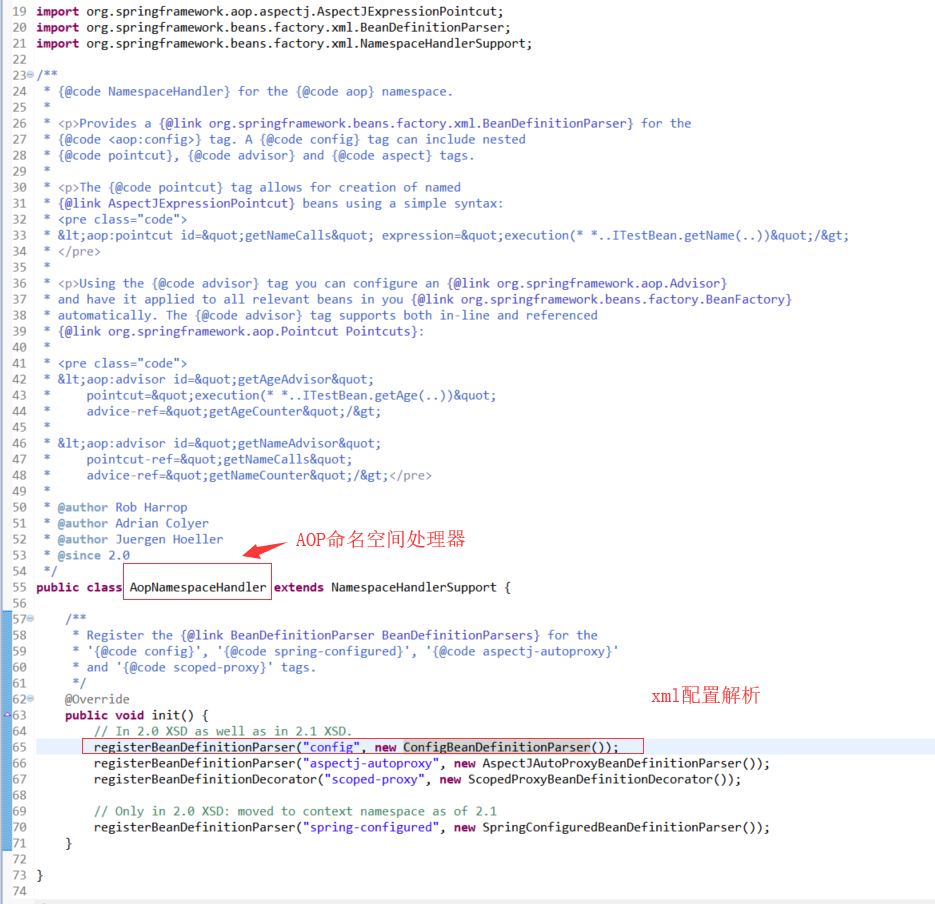
a)解析<aop:config> 及它的子元素
org.springframework.aop.config.ConfigBeanDefinitionParser:

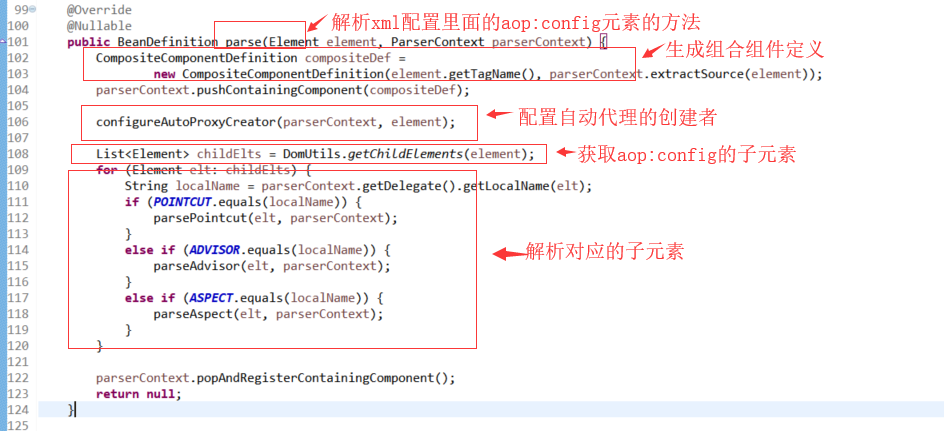
1)注册了autoProxyCreator的Bean定义,它是一个ProxyConfig、BeanFactoryAwrare、BeanPostProcessor
下面来看一下配置自动代理的创建者的代码:
org.springframework.aop.config.ConfigBeanDefinitionParser.configureAutoProxyCreator(ParserContext, Element)
->
org.springframework.aop.config.AopNamespaceUtils.registerAspectJAutoProxyCreatorIfNecessary(ParserContext, Element)
->
org.springframework.aop.config.AopConfigUtils.registerAspectJAutoProxyCreatorIfNecessary(BeanDefinitionRegistry, Object)
->
org.springframework.aop.config.AopConfigUtils.registerOrEscalateApcAsRequired(Class<?>, BeanDefinitionRegistry, Object)

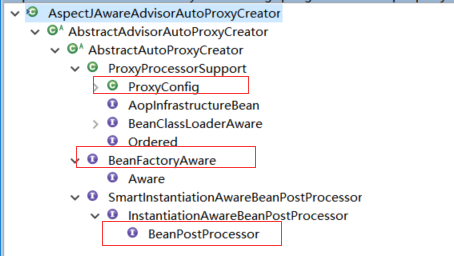
所以说自动代理创建者是一个ProxyConfig、BeanFactoryAwrare、BeanPostProcessor
->
org.springframework.aop.config.AopConfigUtils.findPriorityForClass(String)


说明:
org.springframework.aop.framework.autoproxy.InfrastructureAdvisorAutoProxyCreator现在已经不使用了
org.springframework.aop.aspectj.autoproxy.AspectJAwareAdvisorAutoProxyCreator对应于AspectJ的xml方式
- <aop:config>
- <aop:pointcut id="services" expression="execution(* com.study.leesmall.spring.sample.aop.*.service*(..))" />
- <aop:aspect id="a1" ref="aspectAdviceBean" order="1">
- <aop:before method="before1" pointcut-ref="doMethods" />
- <aop:before method="before2" pointcut-ref="doMethods"/>
- <!--args(tk,..)有两个意思,第一个意思是被增强的方法的第一个参数的类型要和before3的参数tk的类型一样
- 第二个意思是被增强的方法的第一个参数tk要赋值给before3的参数tk;
- arg-names="" 当不能确定方法参数的顺序时可以用这个参数指定arg-names="param1,param2"
- -->
- <aop:before method="before3" pointcut="execution(* com.study.leesmall.spring.sample.aop.*.do*(..)) and args(tk,..)" arg-names=""/>
- <aop:before method="before4" pointcut="execution(* com.study.leesmall.spring.sample.aop.*.do*(..)) and args(tk,ti)"/>
- <aop:around method="arround1" pointcut-ref="services"/>
- <aop:around method="arround2" pointcut="execution(* com.study.leesmall.spring.sample.aop.*.service*(..)) and args(name)"/>
- <aop:after-returning method="afterReturning" pointcut-ref="services" returning="retValue"/>
- <aop:after-throwing method="afterThrowing" pointcut-ref="services" throwing="e"/>
- <aop:after method="after" pointcut-ref="services"/>
- </aop:aspect>
- </aop:config>
查看org.springframework.aop.aspectj.autoproxy.AspectJAwareAdvisorAutoProxyCreator的继承体系:
父类:
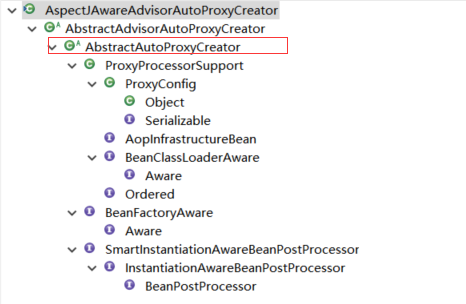
子类:

查看org.springframework.aop.framework.autoproxy.AbstractAutoProxyCreator的继承体系,搞清楚它继承实现了什么,他的父类和子类有哪些
父类:
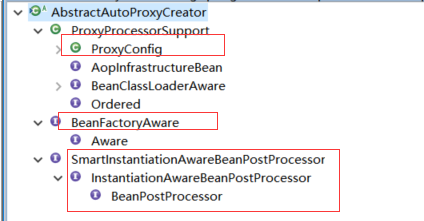
子类:

org.springframework.aop.aspectj.annotation.AnnotationAwareAspectJAutoProxyCreator对应于AspectJ的注解方式:
- <bean id="aspectAdviceBeanUseAnnotation" class="com.study.leesamll.spring.sample.aop.AspectAdviceBeanUseAnnotation" />
- <aop:aspectj-autoproxy></aop:aspectj-autoproxy>
<aop:config proxy-target-class="false" expose-proxy="false">对应代码:
org.springframework.aop.config.AopNamespaceUtils.registerAspectJAutoProxyCreatorIfNecessary(ParserContext, Element)
->
org.springframework.aop.config.AopNamespaceUtils.useClassProxyingIfNecessary(BeanDefinitionRegistry, Element)

2)两种配置方式(advisor和aspectJ)解析之后都是向Bean工厂注册了Pointcut和Advisor的Bean定义
b)<aop:aspectj-autoproxy>开启AspectJ注解支持
1)注册了autoProxyCreator的Bean定义,它是一个ProxyConfig、BeanFactoryAwrare、BeanPostProcessor
org.springframework.aop.config.AopNamespaceHandler.init()
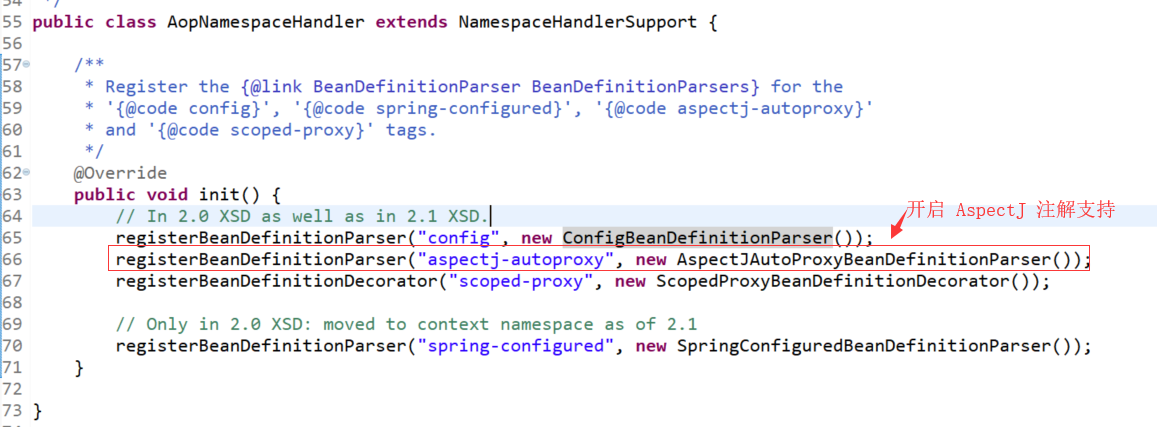
org.springframework.aop.config.AspectJAutoProxyBeanDefinitionParser
org.springframework.aop.config.AspectJAutoProxyBeanDefinitionParser.parse(Element, ParserContext)
org.springframework.aop.config.AopNamespaceUtils.registerAspectJAnnotationAutoProxyCreatorIfNecessary(ParserContext, Element)

- <!--开启AspectJ注解的支持 -->
- <aop:aspectj-autoproxy>
- <!-- 满足name里面的表达式(bean名称的表达式)的才进行切面的处理 -->
- <aop:include name="bean名称的表达式"/>
- </aop:aspectj-autoproxy>

<aop:include name="bean名称的表达式"/>对应源码:
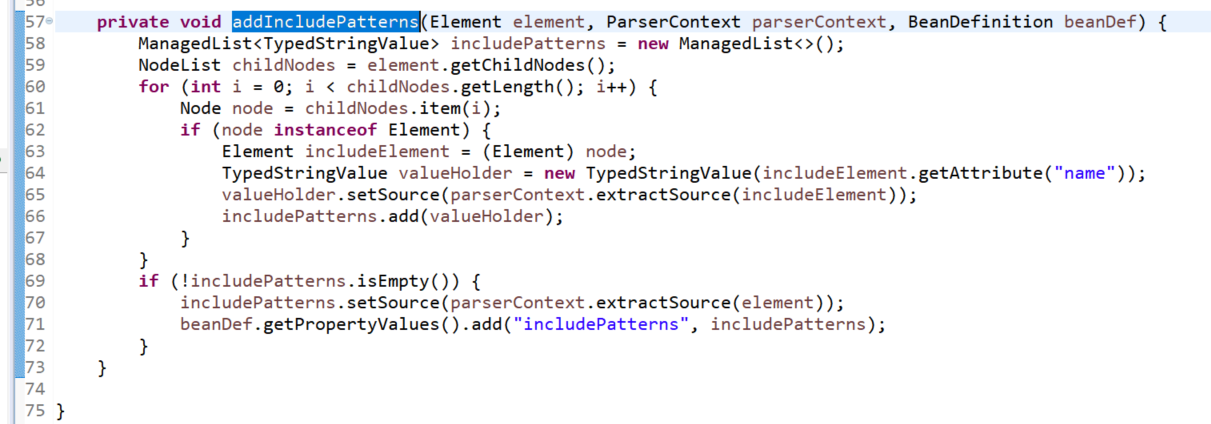
c)AspectJ注解的切面在哪里读取加载的?
可能的地方:
BeanDefinitionRegistryPostProcessor x
BeanFactoryPostProcessor x
InstantiationAwareBeanPostProcessor Bean 实例创建前后
BeanPostProcessor
Xml方式的解析:
org.springframework.aop.aspectj.autoproxy.AspectJAwareAdvisorAutoProxyCreator
注解方式的解析:
org.springframework.aop.aspectj.annotation.AnnotationAwareAspectJAutoProxyCreator
两者的关系:
public class AnnotationAwareAspectJAutoProxyCreator extends AspectJAwareAdvisorAutoProxyCreator
org.springframework.aop.aspectj.annotation.AnnotationAwareAspectJAutoProxyCreator.findCandidateAdvisors()


BeanFactoryAspectJAdvisorsBuilder.buildAspectJAdvisors() 中完成了注解的读取、Advisor对象的创建及缓存。
org.springframework.aop.aspectj.annotation.BeanFactoryAspectJAdvisorsBuilder.buildAspectJAdvisors()

org.springframework.aop.aspectj.annotation.ReflectiveAspectJAdvisorFactory.getAdvisors(MetadataAwareAspectInstanceFactory)

2、 看织入的过程
a) 在哪里做的织入?
在org.springframework.aop.aspectj.annotation.AnnotationAwareAspectJAutoProxyCreator.findCandidateAdvisors()里面打个断点拿到调用栈
入口:
com.study.leesmall.spring.sample.aop.AopMainUseAspectAnnotation

b) 如何判断 Bean 要不要被创建代理?如何排除 advice Bean 的?
排除 advice Bean :
跳过advice bean 跳过带有@Aspect注解的自己,不能自己为自己创建代理,否则进入死循环,如AspectAdviceBeanUseAnnotation
org.springframework.aop.aspectj.autoproxy.AspectJAwareAdvisorAutoProxyCreator.shouldSkip(Class<?>, String)


再次进来,是在 PostProcessAfterInitialization()
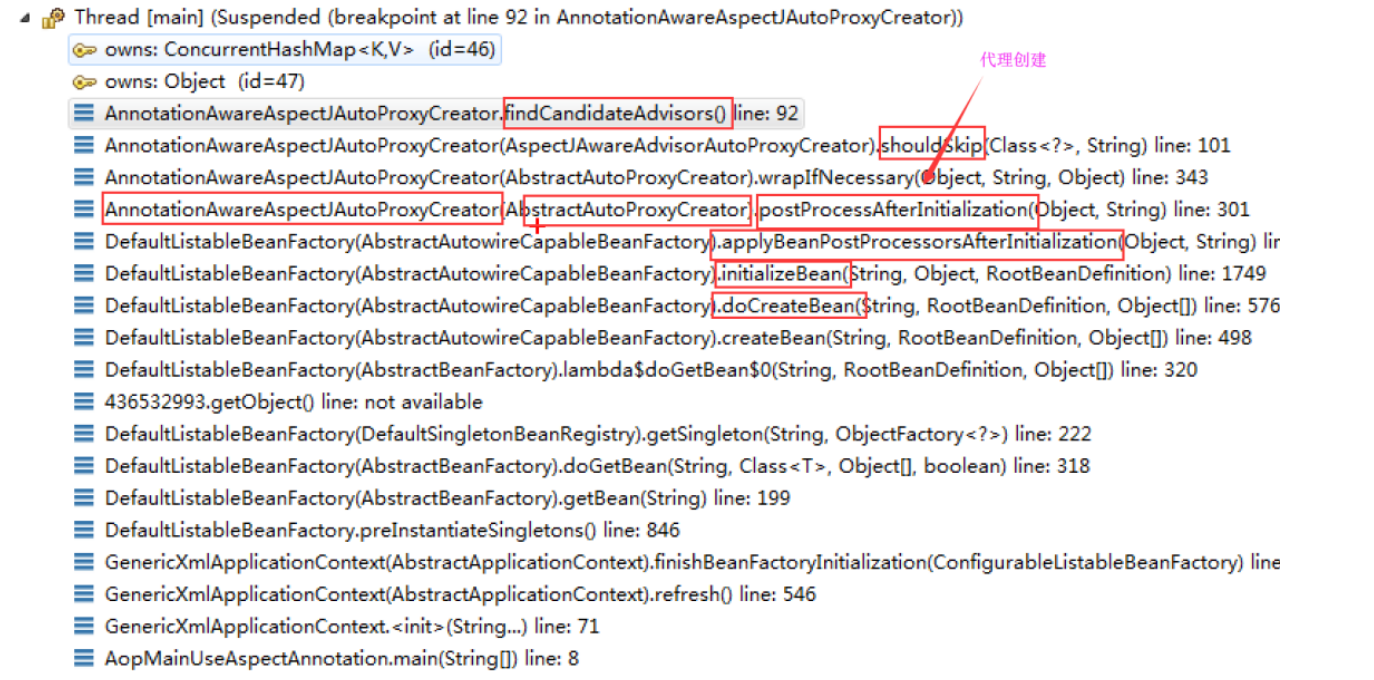
创建代理的方法:
org.springframework.aop.framework.autoproxy.AbstractAutoProxyCreator.wrapIfNecessary(Object, String, Object)
如何判断 Bean 要不要被创建代理:
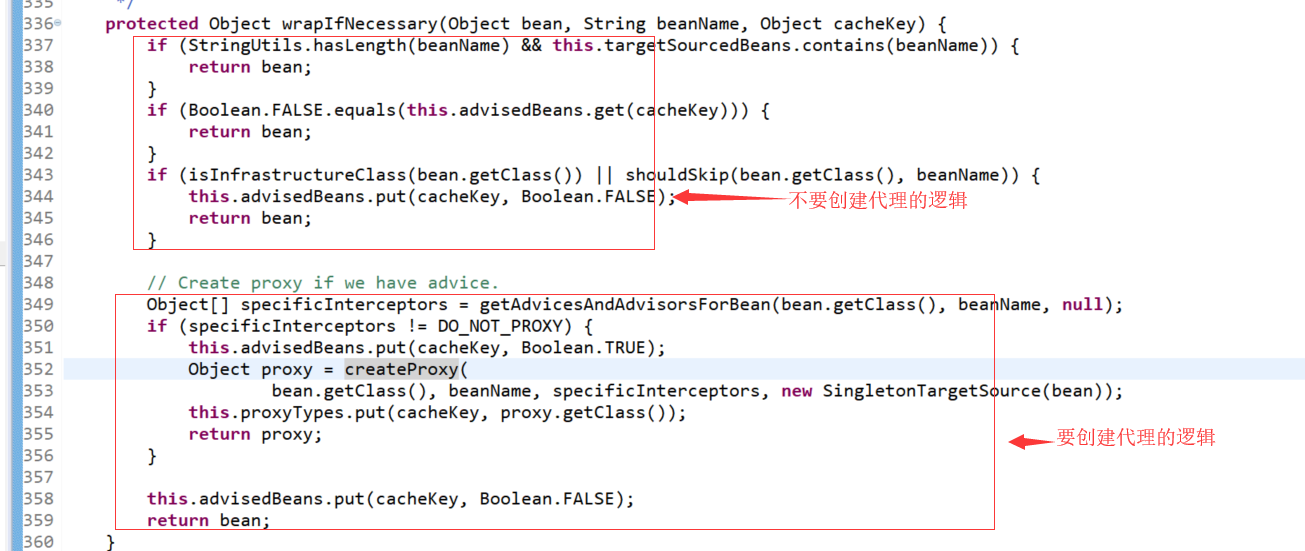
c)如何选择 jdk动态代理 还是cglib的动态代理
org.springframework.aop.framework.autoproxy.AbstractAutoProxyCreator.createProxy(Class<?>, String, Object[], TargetSource)
org.springframework.aop.framework.ProxyFactory.getProxy(ClassLoader)
org.springframework.aop.framework.ProxyCreatorSupport.createAopProxy()
org.springframework.aop.framework.DefaultAopProxyFactory.createAopProxy(AdvisedSupport)
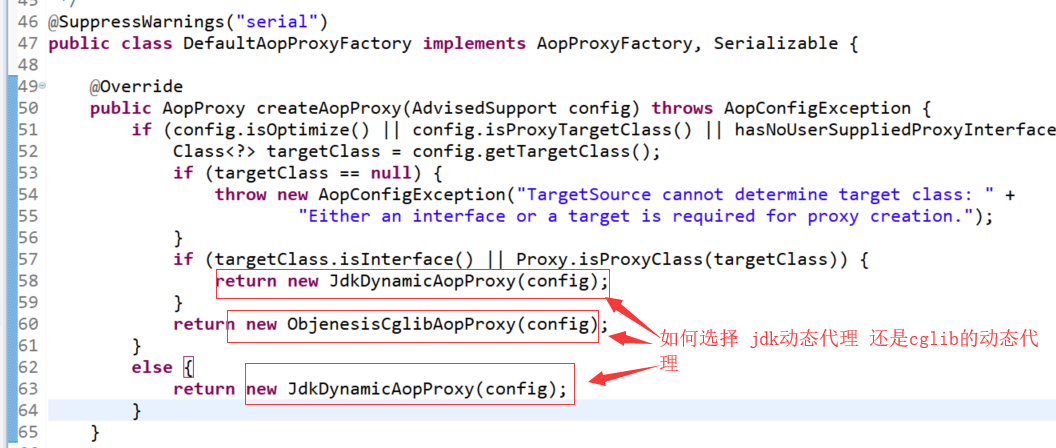
d) 如何来创建代理的,涉及哪些类,如何协作的。
AutoProxyCreator
ProxyConfig ProcxyFactory
AopProxyFactory
AopProxy
3 、看方法被调用时的增强过程
a) 在代理中如何决定对当前方法合格的 advice 的?
调用的 Advisor 中 Pointcut 进行匹配
b) 如何组织多个 advice 执行的?
责任链模式
org.springframework.aop.framework.JdkDynamicAopProxy.invoke(Object, Method, Object[])
org.springframework.aop.framework.ReflectiveMethodInvocation.proceed()
4、源码对应的类图
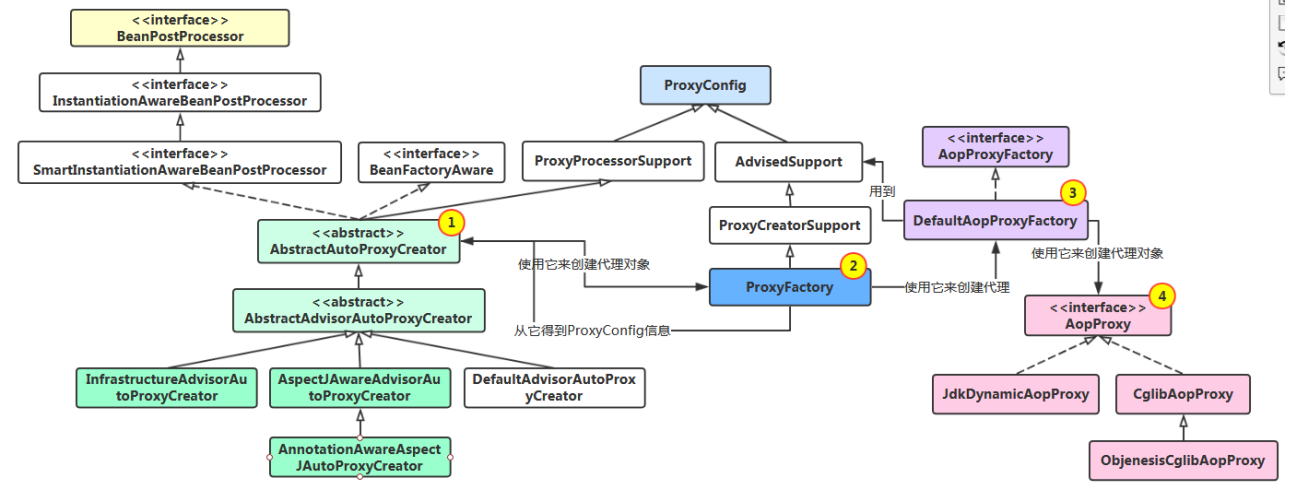
框架源码系列十:Spring AOP(AOP的核心概念回顾、Spring中AOP的用法、Spring AOP 源码学习)的更多相关文章
- Spring的俩大核心概念:IOC、AOP
1.Spring 有两个核心部分: IOC 和 Aop (1)IOC:控制反转,把创建对象过程交给 Spring 进行管理 (2)Aop:面向切面,不修改源代码进行功能增强 2.Spring 特点 ...
- spring源码系列(十): 读取xml入口类 ClassPathXmlApplicationContext 分析
环境准备: 使用spring5.1.6版本 1 xml配置文件 <?xml version="1.0" encoding="UTF-8"?> < ...
- 框架源码系列十二:Mybatis源码之手写Mybatis
一.需求分析 1.Mybatis是什么? 一个半自动化的orm框架(Object Relation Mapping). 2.Mybatis完成什么工作? 在面向对象编程中,我们操作的都是对象,Myba ...
- Docker系列(一)Docker概述,核心概念讲解,安装部署
部分内容参考链接: Docker实战总结(非常全面,建议收藏) 一. Docker概述 Docker是一个开源的应用容器引擎(基于Go语言开发),让开发者可以打包他们的应用以及依赖包到一个可移植的容器 ...
- 【转】Spring学习---Spring IoC容器的核心原理
[原文] Spring的两个核心概念:IoC和AOP的雏形,Spring的历史变迁和如今的生态帝国. IoC和DI的基本概念 IoC(控制反转,英文含义:Inverse of Control)是Spr ...
- 框架源码系列三:手写Spring AOP(AOP分析、AOP概念学习、切面实现、织入实现)
一.AOP分析 问题1:AOP是什么? Aspect Oriented Programming 面向切面编程,在不改变类的代码的情况下,对类方法进行功能增强. 问题2:我们需要做什么? 在我们的框架中 ...
- AOP执行增强-Spring 源码系列(5)
AOP增强实现-Spring 源码系列(5) 目录: Ioc容器beanDefinition-Spring 源码(1) Ioc容器依赖注入-Spring 源码(2) Ioc容器BeanPostProc ...
- spring源码系列8:AOP源码解析之代理的创建
回顾 首先回顾: JDK动态代理与CGLIB动态代理 Spring中的InstantiationAwareBeanPostProcessor和BeanPostProcessor的区别 我们得知 JDK ...
- 框架源码系列六:Spring源码学习之Spring IOC源码学习
Spring 源码学习过程: 一.搞明白IOC能做什么,是怎么做的 1. 搞明白IOC能做什么? IOC是用为用户创建.管理实例对象的.用户需要实例对象时只需要向IOC容器获取就行了,不用自己去创建 ...
随机推荐
- Android软件设计规范---命名规则/代码包设计规则等
如果你将源码作为产品发布,就需要确认它是否被很好地打包并且清晰无误,一如你已构建的其他任何产品. 作为软件设计师,代码即是产品:不仅需要实现功能,还需有“优美.大方”的外表. 标识符命名法,标识符命名 ...
- Windows环境下Composer的安装教程
1.先下载Composer-Setup.exe,下载地址:下载Composer .会自动搜索php.exe的安装路径,如果没有,就手动找到php路径下的php.exe. 2.在PHP目录下,打开php ...
- React Native升级目标SDK
React Native升级目标SDK 打开在 android/app/的build.gradle 找到 android { } 区块 改变以下属性 compileSdkVersion 26 buil ...
- [P2850][USACO06DEC]虫洞Wormholes (最短路)
死活调不出来 后来是发现这题建边的原因…… 吐血.jpg 所谓的虫洞传说也就是负边了 然后这里打的spfa和原来的不一样 感觉hzwer大佬的spfa好强啊…… 也更易写一点 贴代码 #include ...
- Ruby语法基础(一)
Ruby语法基础(一) Ruby是一种开源的面向对象程序设计的服务器端脚本语言,最初由松本行弘(Matz)设计开发,追求『快乐和生产力』,程序员友好型,被称为『human-oriented langu ...
- nullptr/NULL
NULL vs nullptr 在过去,我们如果要表示一个指针为空,我们条件反射肯定会这么写: int *p = NULL; 然而啊,有没有想过这是有问题的,比如下面的这段代码: #include & ...
- modelform的操作以及验证
1,model的两个功能 1,数据库操作 2,验证只有一个clean方法作为钩子来操作,方法比较少 2,form(专门用来做验证的) 根据form里面写的类,类里面的字段,这些字段里有内置的的正则表达 ...
- [原创]RedisDesktopManager工具使用介绍
[原创]RedisDesktopManager工具使用介绍 1 RedisDesktopManager简介 一款能够跨平台使用的开源性redis可视化工具.redis desktop manager主 ...
- 360se打开慢,lsass 过高 , cpu温度上升
rd /s /q "%AppData%\Roaming\Microsoft\Protect" rem C:\Users\Administrator\AppData\Roaming\ ...
- log4j2自定义Appender(输出到文件/RPC服务中)
1.背景 虽然log4j很强大,可以将日志输出到文件.DB.ES等.但是有时候确难免完全适合自己,此时我们就需要自定义Appender,使日志输出到指定的位置上. 本文,将通过两个例子说明自定义APP ...
